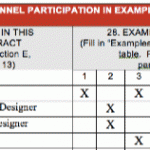
Sometimes contracts are won based solely on proposals. But more often than not, the final selection depends on your ability to win it during the “shortlist presentation.”
Recently, I asked Erica Olson, author of Speak Simple: The Art of Simplifying Technical Presentations to give us some pointers on improving our shortlist presentations.
Here’s a portion of that interview.
When it comes to presenting in front of clients, where do most people go wrong? What do you see as the common mistakes?
The most common mistake I see when conducting presentations or conversations with prospects and clients is the inability to be audience-centric. In general, people want to know how you can help them. They do not wish to hear your ego or your company’s credibility for this conversation. A prospect would not have begun the conversation if you were not viewed as credible already.
During client presentations, the selection committee wishes to hear how you can give them the end result and what they would be looking for while “interviewing” other companies. By educating the listener, you are positioning yourself as the expert without outwardly boasting like many companies do.
Focus on your audience’s needs, not your own. If the goal of your presentation is to win a project, then you’re focused on you, not your audience.
So, your goal shouldn’t be to win the project? Can you explain that?
When most presenters are asked what their goals for the conversation or presentation are, the response is almost always a self-centered, ego-driven, one which leads to pitches that make listeners uncomfortable.
This mindset revolves around selling yourself, proving you’re the best and regurgitating credentials. If you turn it around and ask yourself “what do you wish your audience to take away from this experience” the answer regarding goals will be very different, revolving around educating and building relationships.
Goals about serving the listeners make them willing to be attentive and are receptive to allowing the message to resonate with them. In other words, it sets the foundation for working relationships to be built upon. Your audience-centric goals should sound like “I want the selection committee to understand their own needs and obstacles.” The words used in this conversation are very different than the words that would be used in the self-centric goals.
I do not deny that the presenter cannot achieve the original goals, but that is done by meeting the needs of the listener first.
There are many tips out there about how to improve your presentations. Honestly, it can be a bit overwhelming. Specifically related to shortlist presentations, is there one piece of advice or one focus area that can make a big impact on the success of our presentation?
The biggest mistake I see when it comes to shortlist presentations is teams being ill prepared. This leads to the team of presenters merely repeating the information in the proposal.
The lack of preparation adds excess nervousness because presenters fumble their words, trying to think about what to say which leads to babbling off topic, repeating what the selection committee already knows, and going over the allotted time limit. The solution is to prepare and rehearse the presentation as a team so you don’t need to fumble for words, what information comes next, or miss out on precious Q&A time.
Secondly, many technical professionals feel compelled to speak over their audience’s head with industry jargon and acronyms to appear smart and impress the listener. This misconception creates a wall between the presenter and the selection committee instead of uniting them. The vast volume of knowledge the presenter spews out confuses the listener past the point of being able to ask questions.
One of the perceptions out there is that technical people, the people who end up making the presentations, aren’t necessarily the “life of the party.” They are stereotyped as introverted people who aren’t great at talking. What’s been your experience working with technical people? Is that true? And if so, what can be done?
Every individual has a different personality and learning style that guides them into the industry that they naturally fit best. These individual differences mean that some individuals are natural presenters and others have to work a bit harder at presentations. Selection committees are not looking for the most charismatic presenters to entrust with large sums of money; they are looking for the individuals that can speak simply enough to explain the scope of work and how to avoid potential issues.
They want a team that they feel comfortable working with and that they can trust. Achieving trust by explaining the work simply does not require a specific personality style.
I send people to client presentations and they know there is hundreds of thousands or even millions of dollars on the line. I really feel for them because how can they not be nervous? The stakes are just much higher when you are presenting in a competitive environment versus at a local industry event. Is there any way we can help people reduce the natural anxiety involved with shortlist presentations?
Preparation and practice can cure the majority of the stage fright and nervousness a person feels because they are reassured that they know what to say and will not feel the need to fumble for the next sentence.
This reassurance is a boost of self-confidence in itself. Remembering the presentation is just a conversation among people who want to get to know you cures the rest. In many cases, presenters need a certain amount of nervousness to fuel energy into the presentation. I see this in my clients regularly — they have drab rehearsals and that needed energy comes out in the actual presentation. One way or another, excess stress will be expelled in the form of pacing, fidgeting, or gesturing in a way that doesn’t match the presentation. If an individual is faced with excessive stress or tension, then visualizing a positive outcome, stretching, or breathing exercises may be necessary.
How much should you practice your presentation? Is there a rule of thumb concerning the minimum amount of practice time?
My general rule of thumb in regards to practice is a 10:1 ratio. For every hour of presentation, you want to spend 10 hours in practice.
Although I find this to be true, I acknowledge that every person is different and therefore this advice is subject to variations. A presenter will need more practice for new or freshly altered presentations and less practice for presentations that are recycled or routine with minimal updates. Two dress rehearsals are recommended with props or other demonstrations to make the transition smoothly to using it and putting it away.
I say 50% of your preparation is practice. But for a one-hour presentation I’m not asking you to stand in the conference room and repeat it 10 times. I do ask you to read through your bullet points and walk away to check your email, take a walk, use the bathroom. The time you spend in mindless activity, you should be running through your presentation and every run through should be different, better.
I approach practice the same way I approach studying for exams in college. I practice until practicing does me no more good. It is at that point that I am confidently ready to give a great presentation that is not reliant on notes.
I discussed this in a recent blog post – http://www.speak-simple.com/presentation-time-breakdown/
My mother is getting older and I find myself talking to her almost like I would talk to a child. (Do NOT click any link in any email, mom! That’s not the IRS calling you.) If I talked like this to any other adult, who wasn’t my parent, I imagine them getting pretty offended. In your book, you speak of the importance of interpreting information in your presentation. What caught me, in particular, was the concept of “talking to your grandfather.” Can you explain what you mean by that?
When I was working at the zoo, it was a librarian who told me “If you have any chance of improving your presentation, you need to talk to the old people”.
It took me a while for that advice to sink in and make sense, but it came to me as I sat trying to explain how digital cameras work to my 80-year-old grandfather. Her advice was about the mechanics of presenting: speaking slowly, loudly, and articulating the words you are trying to get across.
I found a second element. It was simplifying the explanation for another person who doesn’t have the same knowledge you have (hence the title of the book “Speak Simple”). As a presenter, it is easy to forget the years it took to build your expertise and to gain the vocabulary you currently have. Your audience doesn’t have that same education. Therefore, your listeners, in any situation, are dependent on how well you explain your knowledge in ways they understand.
Simplifying is not the same as “dumbing it down”, being able to simply explain your business proves you are the expert. It is far more difficult to simplify than to talk in code.
How do you know when you are “dumbing it down” vs. when you are “simplifying” it. How do you recognize the difference?
When a person says dumbing it down, it connotates one person is better than the other. That is derogatory, faulting the audience for not knowing what you know. It does not showcase a friendly, trustworthy, team-minded viewpoint the selection committee or project owner needs.
My application of simplifying is taken from a form of educating I was introduced to called interpretation. Interpretation is not translating one language to another. It educating the value of what appears meaningless.
In my application in the professional world, it means explaining your work to the audience’s level and not using industry jargon and high-level terminology. This concept of simplifying is also rooted in education and connotates that one person is knowledgeable, courteous, and patient enough to meet the needs of his/her listeners.
You recognize the difference by analyzing the words you are using while speaking. If the message is a lecture or you find yourself talking to the audience, you are likely dumbing it down. If you find yourself getting nodding heads and you feel as if you are in a two-way conversation then you are simplifying.
This mindset changes everything. It may be a subtle difference but you’ll find big results in feedback.
You mention using a “script” in your book. When I think of script, I think of a page with all the words I’m going to say. Is that what you mean when you talk about a script?
I do call it a script, however in my definition of “script” is not the write up of every word you wish to say.
Unlike in theatre, I never recommend for a presenter to memorize a script because individuals write and speak differently. If the words are memorized verbatim, it sounds robotic and artificial. Presenters who insist on memorizing a script risk adding the stress of remembering what was on the page, and are more likely, to make a mistake. If they miss a word or line, they end up freezing and having to start over.
Presenters who follow an outline feel more comfortable and less stressed because they have the ability to make eye contact and be more natural with the audience. This outline is what I refer to as the script. I recommend having bullet points to reference and practice what you want to say.
Every practice should have a different set of words. Every time you deliver should be different. This helps a presenter not to feel restricted and update the explanation to appeal to the listeners.
Erica Olson is a professional speaker, interpreter, and presentation coach who helps her clients become comfortable when presenting and relate with their audience.





This meshes nicely with the Heath brothers’ “Made to Stick”. PS…I read to the end, but missed my chance to win. 😀